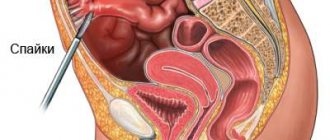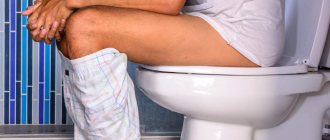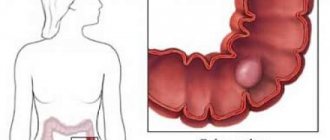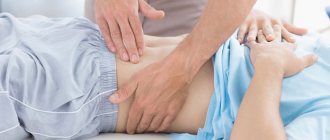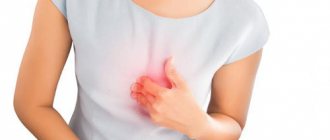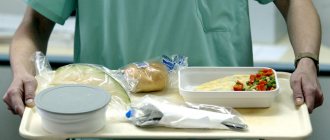Adhesive disease is the appearance of adhesions after surgery (areas of fibrous tissue) formed between the mucous membrane of the inner wall of the abdominal lining (parietal peritoneum) and the loops of the small and large intestines or other organs of the abdominal cavity: gall bladder, liver, bladder, ovaries, uterus.
In normal condition, the organs of the abdominal cavity and their walls are covered with slippery peritoneum, which prevents them from sticking to each other. Adhesions appear after interventions in organ tissue. The symptoms of postoperative adhesions will depend on their number and location. Treatment of adhesions can only be done surgically.
How do adhesions hurt and the reasons for their appearance?
The most common cause of the formation of adhesions is surgery on the abdominal organs. Almost all patients (about 95%) develop adhesive disease after surgical interventions on the abdominal organs.
Adhesions can thicken and increase in size over time, causing problems many years after surgery.
Reasons for the formation of adhesions during operations:
- Touching internal organs with hands.
- Tissue incisions, especially those involving internal organs.
- Blood or blood clots are not completely washed out during surgery.
- Contact with foreign objects of internal organs, for example, with sutures, surgical gloves, gauze.
- Drying of tissues and internal organs.
In rare cases, they are caused by an inflammation process , the appearance of which is not associated with surgery.
These reasons include:
- Performing radiation therapy to treat cancer.
- Appendicitis.
- Infectious diseases of the internal organs of the abdominal cavity.
- Gynecological diseases, for example, adhesions after removal of the uterus.
- Adhesions after laparoscopy.
In rare cases, adhesive disease appears for no apparent reason.
What are adhesions
Adhesions are overgrown connective tissue that forms inside and between organs. An adhesive process occurs as a result of previous inflammation in organs or after incisions during surgical procedures. In the second case, adhesions occur more often.
The danger of connective tissue overgrowth is that it takes up free space in other organs, which can cause a number of problems. The most common example is infertility in women. The overgrown fiber blocks the path of sperm in the fallopian tubes, making conception technically impossible.
In more severe situations, formations block the intestinal lumen, which creates partial or complete intestinal obstruction.
If there are too many tissue connections, the risk of internal organs sticking together increases, which is also very dangerous. If you feel unwell, you should not delay visiting your doctor.
Mechanism of appearance of adhesions
Under normal conditions, the loops of the large and small intestines inside the abdominal cavity can move freely, sliding, relative to each other and to other adjacent organs. This sliding is created by the peritoneum and its thin lubricating film.
During damage to the tissues of the abdominal cavity, an inflammation process occurs, at the site of which connective fibrous tissue , from which seals are formed. With the development of adhesions, the intestines will no longer be able to move freely throughout the abdominal cavity, since its loops are connected to each other, to the abdominal wall or to other abdominal organs.
In areas where adhesions form, the intestines can twist around their axis, which disrupts the normal passage of food or blood supply. Most often this occurs in the small intestine. Typically, the twisting is temporary, but in some cases it may not recover spontaneously.
Diagnostics
Diagnosis begins with collecting anamnesis. The patient describes in detail the nature of the pain. The doctor must definitely clarify whether abdominal surgery has been previously performed, and what inflammatory processes are (or were previously present). To confirm the diagnosis, you will need to undergo ultrasound diagnostics, x-rays or magnetic resonance imaging.
The most accurate and at the same time therapeutic method is laparoscopy. This is a minimally invasive intervention during which the surgeon sees all the smallest details inside the abdominal cavity. If an adhesive process is detected, the specialist can immediately excise the overgrown fibrous tissue.
Laboratory tests are required: blood and urine sampling for general clinical and biochemical tests.
Adhesions: Symptoms of appearance
Doctors associate the signs and symptoms of adhesive disease not with the adhesions themselves, but with the problems they cause. People note different complaints based on where the adhesions appeared and the functioning of which organs they disrupted. Most often, adhesions do not cause any symptoms, as they are simply not detected.
With adhesive disease, abdominal pain appears as a result of tension on the nerves within the adhesions themselves or in the abdominal organs.
Symptoms of adhesions in the abdominal cavity:
- Adhesions that have developed between the uterus or vagina and the intestines can cause pain during sexual intercourse.
- Intestinal adhesions can create pain that is associated with intestinal obstruction, which occurs due to blocking the passage of food through the digestive system.
- Symptoms of adhesions after appendicitis may cause pain when breathing deeply.
Symptoms
The symptoms of the pathology depend on the location of the adhesions, their prevalence and the duration of the disease. In the initial stages of the pathology, only signs of damage to the digestive tract are noted. In advanced situations and with a long course of the disease, extraintestinal manifestations are observed.
Gastrointestinal manifestations
There are four variants of adhesive disease:
- Latent form.
- Adhesive disease with a predominance of pain.
- Adhesive disease with a predominance of dyspeptic disorders.
- Adhesive intestinal obstruction.
Latent form
The latent form precedes all other variants of the course of the disease. The pathology does not manifest itself clinically. After the body’s compensatory capabilities are exhausted, the disease moves to the next stage.
Adhesive disease with predominant pain syndrome
- Dull and aching pain in various parts of the abdomen. The localization of symptoms will depend on the location of the adhesions, the intensity - on the severity of the process and the individual sensitivity of the body.
- Increased pain after physical activity, errors in nutrition, food toxicity. Regular exposure to negative factors overloads the digestive tract, exhausts its compensatory capabilities and leads to the development of intestinal obstruction.
- Moderate dyspeptic symptoms: nausea, heartburn, bowel dysfunction.
Adhesive disease with a predominance of dyspeptic disorders
- decreased appetite;
- nausea, possible vomiting;
- heartburn;
- bloating;
- delay in the passage of gases;
- bowel dysfunction (constipation).
There is periodic occurrence of cramping pain in the abdomen. The pain is not constant and occurs at the height of dyspeptic symptoms.
Adhesive intestinal obstruction
- sharp sudden cramping pain in the lower abdomen;
- nausea and vomiting;
- lack of stool and gas;
- severe weakness, impaired general condition.
Intestinal obstruction occurs as a result of blockage of the lumen by adhesions or when the blood supply to a certain area is disrupted. Without treatment, intoxication increases, there is a deterioration in the general condition, loss of consciousness, and an increase in body temperature.
Adhesive intestinal obstruction is a life-threatening phenomenon. Emergency surgery is required.
Extraintestinal manifestations
With a long course of adhesive disease, the following signs are observed:
- mood changes: irritability, aggressiveness, nervousness, hysteria, imbalance;
- impaired renal function and development of edema;
- signs of vitamin deficiency due to insufficient intake and absorption of nutrients;
- malfunction of the cardiovascular system: heart rhythm disturbances.
Be sure to read: List of painkillers for abdominal pain and their choice in a particular case.
Concomitant extraintestinal symptoms go away after the underlying disease is relieved and the functioning of the digestive tract is normalized.
Adhesions during hysterectomy
When the uterus is removed, the symptoms of the appearance of adhesions in the female body are varied, since this is a rather complex surgical intervention . In gynecology, postoperative female adhesions occur in most patients. The appearance of adhesions is caused by many factors:
- The scale of the surgical intervention (the larger the area of damage, the higher the likelihood of adhesion formation).
- Duration of the operation.
- The presence of internal bleeding, which during resorption is the impetus for the appearance of adhesions.
- Suture infection.
- Blood loss.
- Thin bones and thinness in a woman.
- Genetic disposition.
The main symptoms of uterine adhesions are expressed in the form of disturbances in the processes of defecation and urination, pain in the lower abdomen , as well as disruptions in the functioning of the gastrointestinal tract. To minimize the risk of uterine adhesions, anticoagulants and antibiotics are prescribed. Physiotherapy and physical activity are also recommended.
How to treat adhesions?
Adhesions that do not cause complaints do not require any treatment. There are no conservative methods for treating adhesions.
Treatment of adhesive disease will depend on the degree of formation and location of adhesions and the causes of their occurrence. Often the patient is in no pain and the condition improves without surgery. Before this disease develops, doctors prescribe symptomatic treatment.
Surgical treatment
To get rid of adhesions, as a rule, two methods of surgical intervention are used: open surgery and laparoscopy.
- Open surgery is an intervention in which a large incision is made in the abdominal wall. In this case, under direct visual control, the adhesions are separated using an electrocoagulator or scalpel.
- Laparoscopy is an operation in which a surgeon inserts a camera into the abdominal cavity through a small incision in the abdominal wall. After identifying adhesions, they are separated using scissors or cauterization with electric current.
Most often, they try not to use repeated surgery, since this is characterized by the risk of new adhesions.
Treatment
Conservative therapy is ineffective in the treatment of adhesive disease. The use of medications is justified only to prevent the formation of adhesions after surgery, in case of inflammation of the abdominal organs and other conditions. It is almost impossible to remove already formed adhesions with medications. Medicines are prescribed in complex therapy of the disease and serve to relieve symptoms and alleviate the patient’s condition.
Be sure to read:
Why do intestinal tenesmus occur and how to treat it?
Surgical therapy
Indications for surgery:
- intestinal obstruction due to adhesive disease;
- chronic pain syndrome;
- severe dyspeptic disorders;
- infertility (in women).
Surgical operations for adhesive disease are complex and numerous. The choice of a specific technique will depend on the severity and prevalence of the process:
- If the number of adhesions is small, they are gradually excised and separated from the abdominal organs and peritoneum. The operation is performed predominantly by laparoscopic access using an atraumatic instrument.
- In case of severe damage to a section of the intestine, the development of its torsion and necrosis, resection of the organ is indicated. Part of the intestine is removed, the remaining sections are stitched together. If it is not possible to match the intestinal loops, a stoma is formed - an artificial opening connecting the organ with the skin. A temporary stoma remains until the intestinal viability is restored. A permanent stoma lasts for life.
- With extensive intestinal damage and the development of obstruction, anastomosis may be required. Bypasses serve to restore the passage of food and feces.
Surgical operations in 20% of cases lead to the reappearance of adhesions, so it is important to follow the rules for their prevention.
Recovery after surgery
In the postoperative period, early activation of the patient is practiced. To prevent relapse of the disease, it is recommended to get up 6 hours after laparoscopy. For abdominal surgery, the timing will depend on the speed of recovery. Excessive physical activity is not recommended. At first, the patient just needs to get out of bed, walk to the toilet and back. Next, the range of movements gradually expands.
Drugs
To prevent complications in the postoperative period, the following are prescribed:
- Enzyme preparations that promote the breakdown of newly formed thin adhesions.
- Antibacterial agents for the prevention of infectious complications.
- Hemostatic drugs to stop bleeding (as indicated).
- Painkillers and anti-inflammatory drugs.
- Drugs to stimulate intestinal motility.
Physiotherapy
A good effect has been noticed when using physiotherapy methods:
- ultrasound;
- magnetic therapy;
- electrophoresis.
Physiotherapy
You can start training 3 days after laparoscopy and 7-10 days after laparotomy (in the absence of complications). The selection of exercises is aimed at enhancing motor activity and stimulating the work of the abdominal wall muscles. You should check your training regimen with your doctor.
Nutrition
Nutrition is an important aspect of recovery after surgery. General principles of the diet include:
- frequent split meals (5-6 times a day);
- reducing the volume of portions;
- refusal of food that stimulates gas formation in the intestines and the production of gastric juice;
- compliance with the drinking regime: it is recommended to drink up to 1.5 liters of liquid per day (water, herbal infusions, compote).
On the first day after surgery, only weak broth is allowed. On the second day, light pureed food is allowed. Next, the diet gradually expands to include pureed vegetables, boiled meat, and porridge. It is recommended to follow a special diet for a month. A list of permitted and prohibited products is presented below.
Be sure to read:
Causes of seething and rumbling along the intestines, methods of elimination
| Authorized Products | Prohibited Products |
|
|
Lifestyle
Lifestyle changes after surgery. Certain restrictions apply:
- prohibition on sexual activity;
- prohibition on lifting weights;
- refusal of thermal procedures: it is not recommended to sunbathe on the beach, visit a solarium, sauna, or take a hot bath;
- ban on drinking alcohol;
- limiting physical activity and refusing to play sports.
1 month after a follow-up examination by a doctor, all restrictions can be lifted. If complications develop, the recovery period is prolonged.
How to treat adhesions in a traditional way?
There are many different folk methods that are used for adhesive disease. safety and effectiveness in studies , so you should consult your doctor before using these methods.
Castor oil
Relieves inflammation and pain, and with continued use can reduce scar tissue. It is necessary to wet several layers of wool or cotton cloth and place it on the stomach where it hurts. Wrap the fabric in cling film and secure it with something, tying it around the waist. Then apply a hot heating pad to this area. This heat allows castor oil to penetrate the skin. This bandage must be kept on for 2 hours and then removed. These compresses must be done every other day.
Healing herbs
For treatment, it is recommended to use calendula and comfrey; they can be used in combination with each other or separately.
Calendula and comfrey tea:
- Two cups of water;
- 0.5 teaspoon of calendula flowers;
- 0.5 teaspoon of comfrey leaves.
Add herbs to boiled water. Let it sit for about 20 minutes and express. If necessary, add honey. Use every day.
Calendula and comfrey oil:
- One cup of dried calendula flowers;
- One cup of dried comfrey leaves;
- Olive and castor oil.
Place the herbs into a jar. Using the same ratio of castor and olive oils, add them to the herbs. Place a cloth on the bottom of the multicooker and place a jar of oil and herbs on it. Pour water into the multicooker bowl until it just barely reaches the top of the jar. Set to keep warm mode and keep the jar for five days. Every day you need to add a little water to the multicooker. After five days, drain the oil.
Gently rub this oil into your stomach twice a day. This must be done regularly, over several weeks. We must remember that before using any traditional medicine, you should consult your doctor.
Disease prevention
The appearance of adhesions in the abdominal cavity is difficult to prevent, but it is quite possible to minimize the risk of their formation.
Laparoscopic methods of performing surgical interventions reduce the risk of their formation, since they are done through several small incisions. When performing an operation using a minimally invasive method is impossible for some reason, and a significant incision in the abdominal wall is required, then after the operation is completed, a solution or a special film can be used that reduces the risk of adhesions.
Other methods that can be used during surgery to minimize the possibility of adhesions:
- Careful touching of organs and tissues.
- Use of gloves without talc and latex.
- Using saline solution to hydrate organs and tissues.
- Use of wet wipes and tampons.
- Reducing the duration of surgical intervention.
The appearance of adhesions after surgical interventions on the abdominal organs is a fairly common occurrence. Most often, this does not cause any symptoms and is not life-threatening for the patient. But in some cases, adhesive disease can cause a clear symptomatic picture of intestinal obstruction, which requires surgical intervention to eliminate.
Treatment of adhesions
Is it possible to cure the formed adhesions?
To answer this question, let us once again remember what adhesions are and how they are formed.
Adhesions are the growth of connective tissue that occurs as a protective reaction to any irritation or damage to any organs and tissues of the human body, and, first of all, the outer and inner membranes covering them.
Damage to tissue causes hypoxia and triggers an inflammatory response. The result of inflammation is an effusion of fibrin plaque on the layers of the peritoneum, pleura and other membranes. Fibrin effusion leads to the gluing of the membranes and the growth of connective tissue strands between them.
Causes of adhesions
- any surgical intervention;
- inflammation, especially chronic;
- internal bleeding and hematoma formation;
- trauma, including as a result of exposure to foreign bodies;
- tumor process;
- consequences of peritoneal dialysis;
- endometriosis;
- some other conditions.
Sometimes the cause of adhesions in a patient cannot be determined.
The most common cause of adhesions is considered to be surgical intervention.
The adhesive process can occur after any type of surgery and is expressed in the fusion of any organs or tissues.
Treatment methods for adhesions
Treatment of the adhesive process depends on the location of the adhesions, the degree of its severity, the severity of the dysfunction of the organs involved, as well as the urgency of the situation.
If there are no symptoms, the patient may not even know that he has an adhesive process and may not seek medical help.
Planned treatment is carried out if the patient consults a doctor with non-emergency complaints.
The patient's complaints may be nonspecific and characteristic of many diseases.
After conducting an examination and confirming that the symptoms are caused by adhesions, the doctor may suggest conservative treatment methods.
Conservative treatment
Conservative methods of therapy are aimed at relieving inflammation, softening connective tissue cords and combating the symptoms of the disease.
Conservative treatment may include drug and non-drug treatment: physiotherapy, special medical massage, physical therapy.
Medicines are used for treatment
:
- fibrinolytic drugs;
- enzyme preparations;
- antihistamines to reduce the severity of inflammatory reactions;
- anti-inflammatory drugs;
- painkillers;
- drugs that improve microcirculation and blood rheology.
This therapy can reduce symptoms, but has little effect on adhesions, which in the postoperative period have already formed into dense, strong cords, when any drug treatment is ineffective.
Therapeutic massage and physical therapy
can be used in a comprehensive treatment program for adhesions. The doctor can select a set of special exercises taking into account the characteristics of your surgical intervention, which will help stretch the adhesions and increase the mobility of the organs involved in the adhesive process. However, adhesions will not disappear from such treatment.
Physiotherapy
(magnetic therapy, ultrasound and electrophoresis with enzyme preparations, laser therapy) is successfully used in rehabilitation treatment after surgery. Physical factors have an anti-inflammatory, anti-edematous, analgesic effect, a pronounced repair and regeneration effect, and stimulate cellular immunity. The sooner such rehabilitation treatment is started after surgery, the higher its effectiveness will be. However, if the adhesive process has formed, then no physical factor can eliminate it.
The most effective treatment for adhesions is their prevention during surgery. Application of an anti-adhesion barrier at the surgical site helps prevent the adhesion of damaged surfaces and their subsequent fusion.
Surgery
In the event that the adhesive process significantly disrupts the function of the involved organs, then in some cases they resort to planned surgical treatment
in the form of dissection of adhesions and liberation of the organ from connective tissue cords.
For example, laparoscopic dissection of tubo-peritoneal adhesions - laparoscopic adhesiolysis
- is one of the methods of treating infertility. Laparoscopic intervention is less traumatic, is accompanied by fewer postoperative complications, reduces the risk of recurrent adhesions, and allows for faster rehabilitation of patients.
The surgeon also dissects visible adhesions if he performs an intervention for any other reason.
However, the use of laparoscopy for intestinal adhesions is possible in a limited number of patients. The method, despite its low invasiveness, has limitations in application due to the risk of intestinal damage due to adhesions in the abdominal cavity. Contraindications to its implementation are: a history of more than 3 operations, the presence of symptoms of intestinal obstruction with intestinal dilatation, intestinal necrosis or peritonitis.
It should be remembered that any surgical intervention, even for the purpose of cutting/destructing adhesions, is a traumatic factor and leads to the formation of new ones.
Therefore, at the end of the operation, it is recommended to use an anti-adhesion gel to prevent the recurrence of adhesions. Antiadhesin gel containing hyaluronic acid has high anti-adhesive effectiveness. After introduction into the abdominal cavity, the gel envelops the damaged surfaces, separating and preventing them from sticking together, after which it almost completely dissolves after 7 days, by which time the risk of adhesions is greatly reduced.
If symptoms of acute intestinal obstruction develop, emergency surgical treatment
.
Suspicion of acute intestinal obstruction arises when the following symptoms develop: the patient, against the background of prolonged stool retention, develops intense abdominal pain, nausea, vomiting, fever, and symptoms of general intoxication. The development of this condition is extremely life-threatening and requires urgent medical attention.
It is necessary to understand that acute intestinal obstruction can be a consequence not only of adhesions, but also of other pathological conditions: tumor, foreign body, gallstones, etc.
If intestinal obstruction develops in a surgical hospital, the doctor, depending on the cause of the obstruction, may begin conservative treatment:
- gastric lavage;
- high siphon enemas;
- antispasmodics or drugs that stimulate motor skills;
- infusion therapy;
- antibacterial therapy.
If conservative therapy is ineffective, as well as if intestinal obstruction is caused by a tumor or torsion of intestinal loops with disruption of their blood supply, then emergency surgery with a wide opening of the abdominal cavity is necessary.
During the operation, the surgeon conducts a complete inspection of the intestines and other internal organs, determines the cause of the obstruction and, if possible, eliminates it. In some cases, for example, a severe tumor process, it is impossible to completely eliminate the cause of intestinal obstruction, then the surgeon creates a stoma (intestinal opening) on the anterior abdominal wall.
The adhesive process is a pathology that is potentially dangerous for the patient. The fusion of internal organs leads to disruption of their functioning, which is accompanied by discomfort, the development of pain, and in some cases can lead to serious complications.
Therefore, it is extremely important to anticipate the risks and discuss adhesion prevention with your surgeon before any planned surgical treatment. Applying anti-adhesive gel to the surgical area reduces the risk of adhesions and the development of adhesions. Hyaluronic acid contained in the anti-adhesive gel Antiadhesin promotes hydration and regeneration of damaged tissues. Antiadhesin gel, after performing its function, undergoes biodegradation due to the body’s natural enzymes and macrophages.
The best treatment for adhesions is their prevention.
